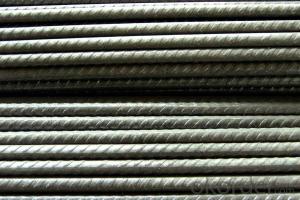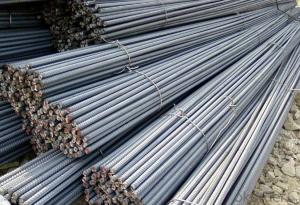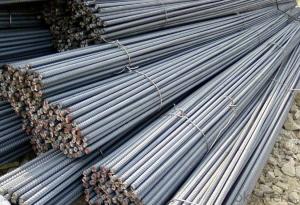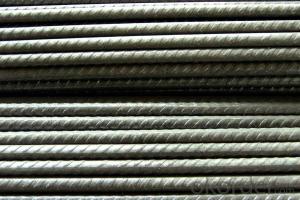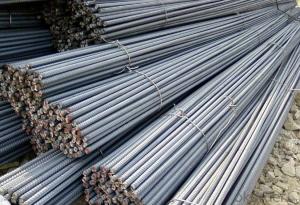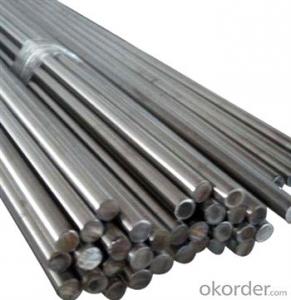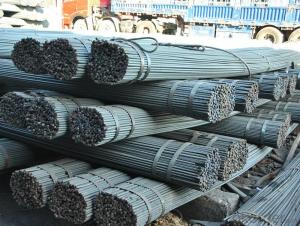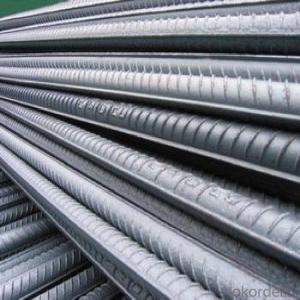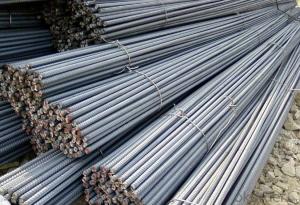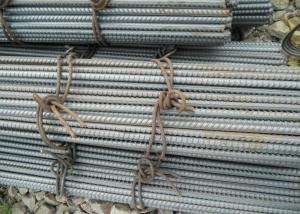Deformed Bar High Quality Hot Rolled 6MM-50MM
- Loading Port:
- Tianjin
- Payment Terms:
- TT or LC
- Min Order Qty:
- 25 m.t.
- Supply Capability:
- 10000 m.t./month
OKorder Service Pledge
OKorder Financial Service
You Might Also Like
Product Description:
OKorder is offering high quality Hot Rolled Steel I-Beams at great prices with worldwide shipping. Our supplier is a world-class manufacturer of steel, with our products utilized the world over. OKorder annually supplies products to European, North American and Asian markets. We provide quotations within 24 hours of receiving an inquiry and guarantee competitive prices.
Product Applications:
Deformed bar is widely used in buildings, bridges, roads and other engineering construction. Big to highways, railways, bridges, culverts, tunnels, public facilities such as flood control, dam, small to housing construction, beam, column, wall and the foundation of the plate, deformed bar is an integral structure material. With the development of world economy and the vigorous development of infrastructure construction, real estate, the demand for deformed bar will be larger and larger
Product Advantages:
OKorder's Steel I-Beams are durable, strong, and resist corrosion, exact size, regular package, chemical and mechanical properties are stable.
Main Product Features:
· Premium quality
· Prompt delivery & seaworthy packing (30 days after receiving deposit)
· Corrosion resistance
· Can be recycled and reused
· Mill test certification
· Professional Service
· Competitive pricing
Product Specifications:
Manufacture: Hot rolled
Grade: BS4449
Certificates: ISO, SGS, BV, CIQ
Diameter: 6mm,8mm,10mm,12mm,14mm,16mm,18mm,20mm,
22mm,25mm,28mm,32mm,36mm,40mm,50mm
Length: 6M, 9M,12M or as required
Packaging: Export packing, nude packing, bundled
Chemical Composition: (Please kindly find our chemistry of our material based on HRB500 as below for your information)
Grade | Technical data of the original chemical composition (%) | ||||||
C | Mn | Si | S | P | V | ||
HRB400 | ≤0.25 | ≤1.60 | ≤0.80 | ≤0.045 | ≤0.045 | 0.04-0.12 | |
Physical capability | |||||||
Yield Strength (N/cm²) | Tensile Strength (N/cm²) | Elongation (%) | |||||
≥400 | ≥570 | ≥14 | |||||
Theoretical weight and section area of each diameter as below for your information:
Diameter(mm) | Section area (mm²) | Mass(kg/m) | Weight of 12m bar(kg) |
6 | 28.27 | 0.222 | 2.664 |
8 | 50.27 | 0.395 | 4.74 |
10 | 78.54 | 0.617 | 7.404 |
12 | 113.1 | 0.888 | 10.656 |
14 | 153.9 | 1.21 | 14.52 |
16 | 201.1 | 1.58 | 18.96 |
18 | 254.5 | 2.00 | 24 |
20 | 314.2 | 2.47 | 29.64 |
22 | 380.1 | 2.98 | 35.76 |
25 | 490.9 | 3.85 | 46.2 |
28 | 615.8 | 4.83 | 57.96 |
32 | 804.2 | 6.31 | 75.72 |
36 | 1018 | 7.99 | 98.88 |
40 | 1257 | 9.87 | 118.44 |
50 | 1964 | 15.42 | 185.04 |
FAQ:
Q1: How do we guarantee the quality of our products?
A1: We have established an advanced quality management system which conducts strict quality tests at every step, from raw materials to the final product. At the same time, we provide extensive follow-up service assurances as required.
Q2: How soon can we receive the product after purchase?
A2: Within three days of placing an order, we will begin production. The specific shipping date is dependent upon international and government factors, but is typically 7 to 10 workdays.
Q3: What makes stainless steel stainless?
A3: Stainless steel must contain at least 10.5 % chromium. It is this element that reacts with the oxygen in the air to form a complex chrome-oxide surface layer that is invisible but strong enough to prevent further oxygen from "staining" (rusting) the surface. Higher levels of chromium and the addition of other alloying elements such as nickel and molybdenum enhance this surface layer and improve the corrosion resistance of the stainless material.
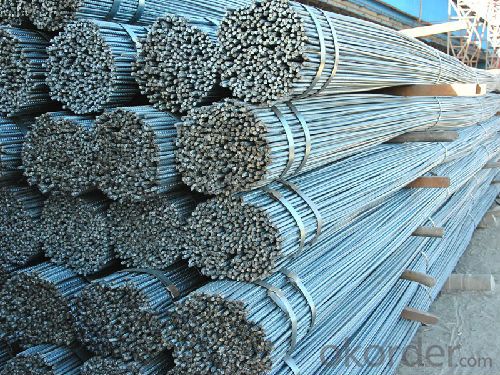

- Q: How are steel rebars protected during the concrete pouring process?
- During the concrete pouring process, steel rebars are protected in several ways to ensure their longevity and structural integrity. Firstly, before the concrete is poured, the rebars are carefully cleaned to remove any rust, dirt, or other contaminants that could compromise the bond between the rebar and the concrete. This is typically done by using a wire brush or other mechanical means. Once the rebars are cleaned, they are usually coated with a protective layer or coating. One common method is to apply an epoxy coating to the rebars. This coating acts as a barrier, preventing moisture and chemicals from reaching the steel and causing corrosion. Epoxy coatings are often used in high-risk environments such as marine structures or areas with high chloride content. Another method of protection involves using corrosion inhibitors. These inhibitors are added to the concrete mix, which then forms a protective layer around the rebars. The inhibitors work by reducing the corrosive effects of chloride ions, oxygen, and other chemicals that could lead to corrosion. Additionally, during the pouring process, it is important to ensure proper concrete cover over the rebars. Concrete cover refers to the thickness of the concrete layer between the surface and the rebar. Adequate concrete cover helps protect the rebars from exposure to moisture, chemicals, and other environmental factors. To achieve the required concrete cover, steel stirrups or spacers are placed around the rebars to maintain a specific distance between the rebar and the formwork. This ensures that the concrete is evenly distributed around the rebars, providing them with the necessary protection. In summary, steel rebars are protected during the concrete pouring process through various methods such as cleaning, applying protective coatings, using corrosion inhibitors, and maintaining proper concrete cover. These measures help to prevent corrosion and ensure the durability and strength of the reinforced concrete structure.
- Q: Are steel rebars suitable for reinforcement in parking garages?
- Yes, steel rebars are highly suitable for reinforcement in parking garages. Steel rebars provide excellent structural integrity, durability, and resistance to corrosion, making them an ideal choice for reinforcing concrete structures like parking garages. Their high tensile strength helps absorb the stress and load-bearing requirements of the parking garage, ensuring its long-term stability and safety.
- Q: How are steel rebars bent or shaped to fit specific construction requirements?
- Rebar bending, a commonly used technique in construction, involves shaping steel rebars to meet specific requirements. This process utilizes specialized machines that exert force on the rebars, causing them to bend or conform to desired specifications. The method employed for bending steel rebars varies depending on the complexity of the desired shape. For simpler bends, such as 90-degree angles, manual tools like hammers or manual rebar benders can be utilized. These tools allow construction workers to manually apply force and shape the rebars by hand. However, for more intricate shapes or larger quantities of rebars, mechanical rebar benders are preferred. These machines are equipped with bending dies and rollers that provide greater precision and efficiency in bending the steel rebars. Depending on the size and requirements of the construction project, these machines can be operated manually or powered by hydraulics or electricity. In certain cases, Computer Numerical Control (CNC) machines are employed, particularly for projects with complex or customized rebar shapes. These machines are programmed to automatically bend the rebars to desired angles and shapes, ensuring high levels of precision and accuracy in the construction process. It is important to note that rebar bending extends beyond simple bends or shapes. Some architectural or structural requirements call for curved or spiraled rebars. In such instances, specialized bending machines are used to gradually and precisely apply controlled force to the rebars, resulting in smooth curves or spirals. In summary, the process of bending or shaping steel rebars to meet specific construction requirements involves the use of manual tools, mechanical benders, or CNC machines. These methods guarantee precise bending and shaping of the rebars according to design specifications, facilitating efficient and accurate construction of reinforced concrete structures.
- Q: What are the guidelines for proper bending of steel rebars on construction sites?
- The guidelines for proper bending of steel rebars on construction sites are essential to ensure structural integrity and safety of the building. Here are some key guidelines to follow: 1. Use the right tools: Utilize a proper rebar bending machine or manual rebar bender specifically designed for steel rebars. These tools ensure precise bending without causing damage or weak spots on the rebar. 2. Determine the required bend angle: Measure and mark the required bend angle on the rebar accurately before bending. Use a protractor or a bending template to achieve the desired angle. 3. Follow the bending radius: The bending radius refers to the minimum radius that the rebar can be bent without causing any damage. Always adhere to the recommended bending radius provided by the manufacturer or structural engineer to avoid fractures or deformations. 4. Secure the rebar firmly: Prior to bending, securely fasten the rebar in the bender to prevent slipping or movement during the bending process. This ensures precise bending and reduces the risk of accidents. 5. Gradual bending process: When bending the rebar, apply gradual pressure and avoid sudden or excessive force. Gradual bending minimizes the risk of cracks or fractures and maintains the rebar's structural integrity. 6. Inspect the bend: After bending, carefully inspect the rebar to ensure it matches the desired angle and there are no visible defects or stress marks. Any faulty bends should be rectified immediately. 7. Proper storage: Store the bent rebar in a designated area, preferably on a flat surface, to prevent distortion or damage. Avoid placing heavy objects on top of the bent rebar to maintain its shape and strength. 8. Follow safety precautions: Always wear appropriate personal protective equipment (PPE), such as gloves and safety glasses, during bending operations. Ensure the work area is clear of obstacles and other workers to avoid accidents. 9. Maintain documentation: Document the bending process, including the angle, radius, and any deviations or issues encountered. This information can be useful for quality control purposes and future reference. 10. Compliance with building codes: Ensure that the bending process complies with local building codes and regulations. Seek guidance from a structural engineer or relevant authorities if necessary. By following these guidelines, construction professionals can ensure the proper bending of steel rebars, resulting in a structurally sound and safe building.
- Q: How do steel rebars affect the overall durability of concrete?
- Steel rebars have a significant impact on the overall durability of concrete structures. The presence of steel rebars in concrete enhances its strength and resistance to various external forces and environmental conditions. One of the primary functions of steel rebars is to provide tensile strength to concrete, which is otherwise weak in resisting tension. Concrete is excellent in compression but tends to crack under tension. By embedding steel rebars within the concrete, these cracks are effectively controlled and prevented from expanding, thus improving the durability of the structure. Steel rebars also help in increasing the flexural strength of concrete, making it more capable of withstanding bending and deformations. This is particularly crucial in structures such as beams, columns, and slabs that experience significant loads and forces during their lifespan. Moreover, steel rebars act as a reinforcement in concrete, improving its resistance to external factors such as earthquakes, wind, and impact loads. The presence of rebars helps in distributing and dissipating these forces throughout the structure, reducing the chances of structural failure and increasing the overall durability. Another critical aspect is the prevention of corrosion in reinforced concrete structures. The steel rebars are typically coated with materials that protect them from corrosion caused by moisture and chemical reactions. This protective coating, coupled with the alkaline environment of concrete, creates a barrier that significantly slows down the corrosion process, thereby increasing the longevity and durability of the concrete structure. In conclusion, steel rebars play a vital role in enhancing the overall durability of concrete structures. They provide the necessary tensile strength, improve flexural strength, enhance resistance to external forces, and prevent corrosion. By incorporating steel rebars, concrete becomes more robust, long-lasting, and capable of withstanding various challenges, ensuring the longevity and safety of the structure.
- Q: What is the lifespan of steel rebars in concrete?
- The lifespan of steel rebars in concrete can vary depending on various factors such as the quality of the steel, the level of corrosion protection, and the environmental conditions. However, in general, steel rebars in well-designed and properly maintained concrete structures can have a lifespan of 50 to 100 years or even longer.
- Q: Can steel rebars be used in highway barrier construction?
- Yes, steel rebars can be used in highway barrier construction. They are commonly used as reinforcement in concrete barriers to enhance their strength and durability.
- Q: How do steel rebars affect the overall fire rating of a building?
- Steel rebars can have a positive impact on the overall fire rating of a building. By reinforcing concrete structures, rebars can help enhance the fire resistance of the building. Steel has high melting and ignition temperatures, which means it can withstand heat and maintain its structural integrity for longer periods during a fire. This additional durability provided by rebars can help prevent structural collapse, allowing occupants more time to evacuate safely and aiding firefighters in their efforts to suppress the fire.
- Q: What is a steel rebar?
- A steel rebar is a commonly used construction material that consists of a steel rod or bar with ribbed patterns. It is primarily used to reinforce concrete structures, providing strength and stability to the overall construction.
- Q: Are steel rebars suitable for use in tunnels and underground mines?
- Yes, steel rebars are suitable for use in tunnels and underground mines. Steel rebars, also known as reinforcement bars, are commonly used in construction for their strength and durability. In tunnels and underground mines, where structural integrity is crucial, steel rebars provide the necessary reinforcement to withstand the heavy loads and pressures associated with these environments. Steel rebars have excellent tensile strength, which allows them to resist bending and cracking under high stress. This is particularly important in tunnels and underground mines, where the surrounding rock and soil can exert significant pressure on the structure. By reinforcing the concrete or other structural materials with steel rebars, the overall strength and stability of the tunnel or mine are enhanced, reducing the risk of collapse or damage. Furthermore, steel rebars are resistant to corrosion, making them suitable for use in underground environments where moisture and chemical exposure are common. Corrosion can weaken the structural integrity of reinforcement materials, compromising the safety of the tunnel or mine. Steel rebars, on the other hand, provide long-lasting reinforcement, ensuring the longevity and reliability of the infrastructure. In addition, steel rebars can be easily fabricated and installed, making them a convenient choice for tunnel and underground mine construction. They can be cut and bent to specific shapes and sizes, allowing for customized reinforcement solutions that meet the unique requirements of each project. This versatility and ease of installation make steel rebars a practical choice for tunnels and underground mines, where complex geometries and challenging conditions are often encountered. Overall, steel rebars are well-suited for use in tunnels and underground mines due to their strength, durability, corrosion resistance, and ease of installation. By using steel rebars as reinforcement, these structures can be built to withstand the demanding conditions and ensure the safety of workers and the longevity of the infrastructure.
Send your message to us
Deformed Bar High Quality Hot Rolled 6MM-50MM
- Loading Port:
- Tianjin
- Payment Terms:
- TT or LC
- Min Order Qty:
- 25 m.t.
- Supply Capability:
- 10000 m.t./month
OKorder Service Pledge
OKorder Financial Service
Similar products
Hot products
Hot Searches
Related keywords
